Our favourite places to stay on this sleepy Cebu island.
Krysten Kaladkarin Tells Us About Ukraine: Her Experiences, Hopes, and Dreams
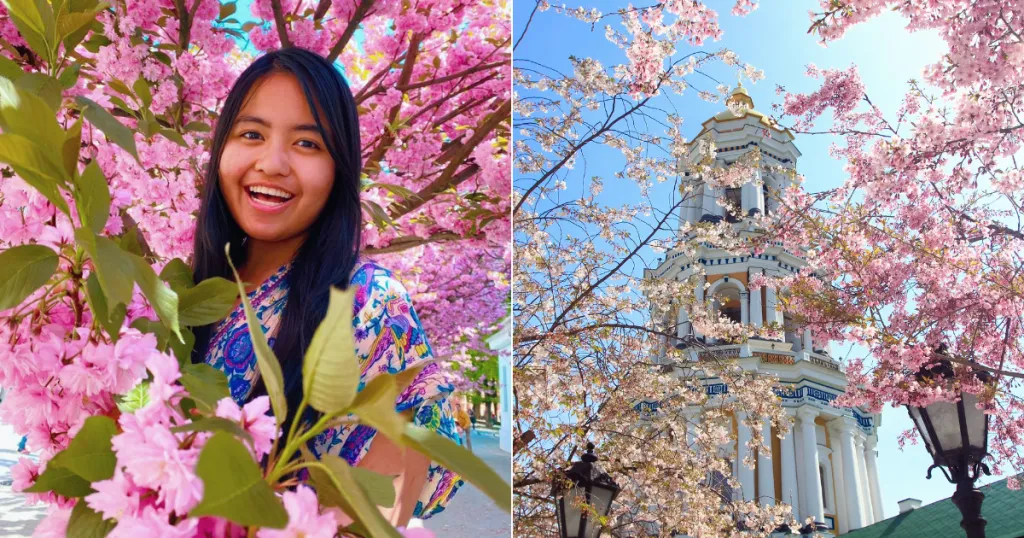
For many people, solo travelling is just a phase. They treat it as a journey to find themselves — soul searching, some would even call it. Not for Krysten Boado, also known as Krysten Kaladkarin. When I first interviewed her in 2018, Krysten had been hitchhiking for 11 months. As of 2022, she continues to explore foreign grounds, with eyes open to new cultures and experiences. And while her mindset about solo travel has radically changed since 2018, Krysten is still the same woman, only now, with a much deeper understanding of the world around her.
Also read: Why You Should Explore the Philippines for Your First Solo Travel
Krysten claims to have found her home in Ukraine, where she has experienced peace and war, fortune and tragedy, pain and love, and everything in between. As of writing, it has been almost five years of travel for her; and while Krysten has been to over 10 countries, she reveals that she’s developed a special love for the war-torn country. I’m honoured to have chatted with Krysten about her incredible experiences in the country, how her life changed during the war, and her dreams and vision for her life of travel ahead.
For a long-time hitchhiker, you sound very attached to Ukraine. What is it about the country that you love so much?
“As with all of the countries I’ve been to on my trip, I fell in love with Ukraine because of its people. Sure, the country has its own share of stunning landscapes — tranquil seas, snow-capped mountains, endless sunflower fields — but you can go anywhere in the world and find nature. People and their stories, on the other hand, are what make a country special, and unique.”
On celebrating Ukrainian Easter

“When we celebrated Easter in 2021, I had the privilege to learn how to paint pysanky, Ukrainian Easter eggs adorned with stunning Ukrainian folk motifs. These eggs symbolise a multitude of things: protection from evil, new life, rebirth, happiness, and hope.
An extremely talented Hutsul artisan, Galia, taught me the intricate art of painting pysanky. The entire experience took a full day, especially since I chose to make an Easter egg with Hutsul motifs to honour Galia and her work. But, Galia was very patient with me; even though my hands were shaky and my designs were far from perfect, she encouraged me and reminded me that my work was beautiful.”
On meeting friends and family
“During my last summer in Odessa, I was hosted by my local friends, Natasha and Igor. I was only supposed to stay for two days, but Natasha and I felt an instant connection with each other and became fast friends. We spent the summer sliding down waterparks, enjoying the city’s nightlife, and getting lost underneath the Odessa catacombs. Ever-helpful Natasha hosted me while I was waiting for my Bulgarian visa to be approved, so that I could continue my journey. We remain in touch with each other, hoping we’ll stay lifelong friends.
I also met my sisters, Aida and Gayana. These two beautiful souls became my family in Kyiv. Our memories are endless, but the most memorable one was our trip to their hometown, Kherson. The girls invited me to meet their mamochka (mother) and babushka (grandmother), and I also saw the city they grew up in.
Even before I came to Kherson, their family already considered me part of their own. It was easily one of the best few weeks I’ve ever had in Ukraine. Our mamochka prepared hearty borscht and baked chicken for us. She welcomed me with a warm embrace, much like a daughter coming home. Well, I really felt like I was coming home.”
On experiencing Ukraine like a local
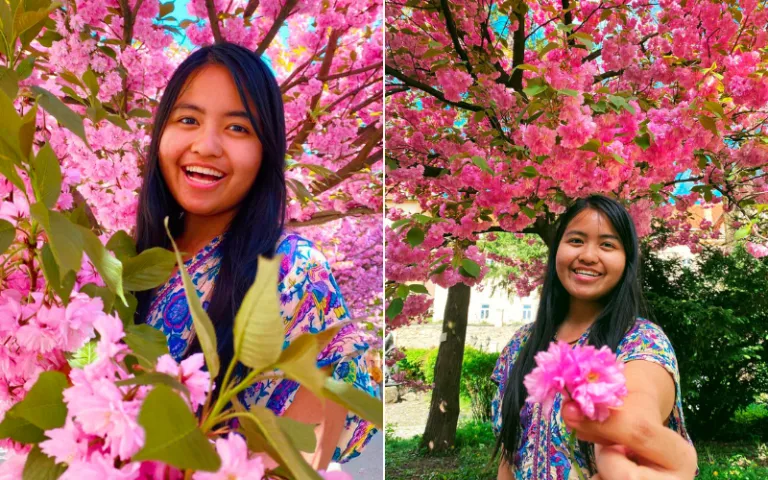
“During my first few days in Ukraine, my life was filled with sunshine. My family and I prepared various meals at home, from blinis (traditional pancakes) to pelmeni (traditional dumplings). The girls also taught me how to make dolma, grape leaf rolls stuffed with rice and minced meat. This dish honours both their Armenian and Ukrainian roots, as it was an integral part of their heritage cuisine. My grandma Lyuda made sure I was stuffed, as all babushkas do. She kept asking me if I wanted to eat and was worried I wasn’t eating enough. Believe me, I always was.
We had countless evenings of wine and singing. I played the guitar for our family while Mamochka and Aunt Elya sang. We also went for a walk in Kherson’s Slavy Park and got to get a glimpse of slow-paced local life: grandfathers fishing, couples holding hands on benches, families having a stroll by the Dnieper River.
As I said, it felt like home. This is what Ukraine was.”
What was your experience like hitchhiking to Ukraine amid a pandemic?
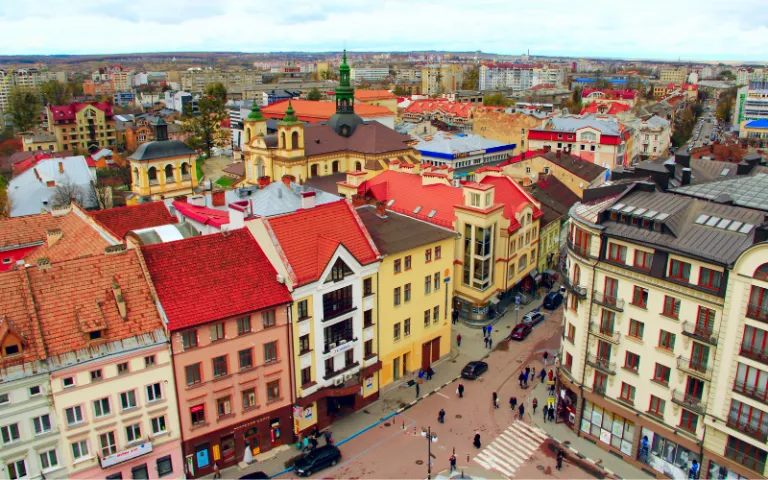
“Ukraine was one of the first few countries that opened to travellers during the height of the pandemic. So for me, it symbolised a place where I could start anew, where I could do meaningful work while waiting for the world to fully open again.
Compared to my previous experiences, my trip to Ukraine was a very easy one. I found an alternative learning school looking for volunteer teachers in Ivano-Frankivsk, a small city near the Carpathian Mountains. I decided to apply for this position because I liked the school’s approach to learning, which focuses on providing highly personalised education, encouraging independent learning, shaping students’ global mindset, and most importantly, fostering a love for the outdoors.
The school took care of my volunteer visa and provided me with a cheap flight ticket (from Astana to Kyiv) since they needed someone to fill the position right away. The borders to Kazakhstan’s neighbouring countries were still closed due to COVID-19.
You can say I hitchhiked that plane, but for me, it was a ticket to the country that I would soon call my home.”
What are your favourite things about Ukrainian culture?
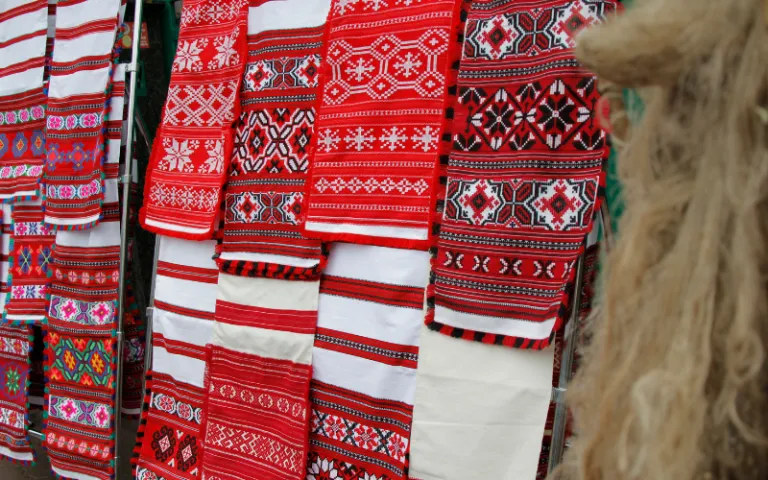
“Ukrainian culture is very rich, from its delicious cuisine to its colourful celebrations. When I came to Ukraine, I fell in love with the country’s folk art.
As an artist and an art enthusiast, I always take the opportunity to get a closer look at a country’s traditional art forms. Ukraine has a glorious history of folk art that is integral to its culture and traditional life. Most of these crafts are centuries old and reflect the identity of the Ukrainian people.
Examples of Ukrainian folk art include the pysanky. Other local folk arts include Petrykivka painting, a traditional Ukrainian ornamental art style often seen decorating traditional Ukrainian homes and every household item.
Of course, Ukrainian folk art will not be complete without vyshyvanka (Ukrainian embroidery), the country’s national costume. Often referred to as the country’s genetic code, it takes up an important spot among Ukraine’s decorative arts. Much like pysanky, vyshyvanka varies from region to region, village to village.”
On how the war affects Ukrainian culture and art
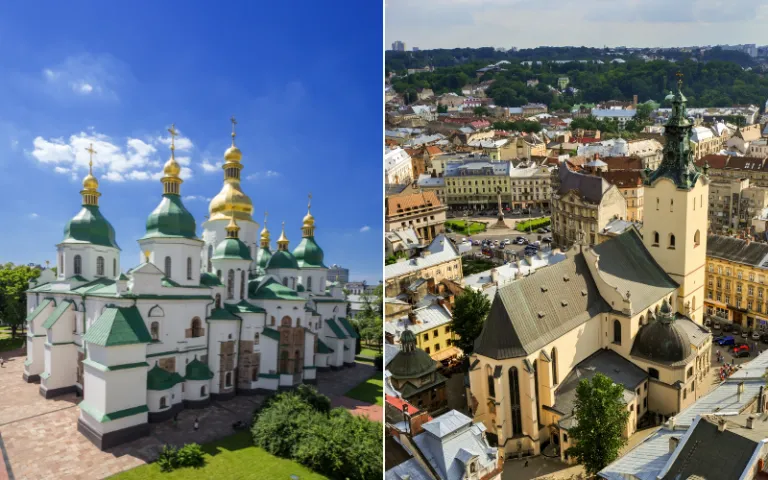
“The art of vyshyvanka suffered a fierce blow with USSR’s attempt at Russification. When the country was part of the Soviet Union, locals were not allowed to wear their embroidered clothes. They had to bury their vyshyvanka underground to hide any trace of being Ukrainian.
Such historical consequence is no different from the one Ukraine is suffering from now. What’s happening in Ukraine is a genocide of Ukrainians and a modern-day attempt at Russification. Because of the invasion, these traditional forms of art are now endangered. During the first week of the war alone, Russian forces have already burned a museum housing the paintings of famous local folk artist Maria Prymachenko.
Ukraine is home to several UNESCO World Heritage sites, including Lviv’s picturesque historical architecture at the heart of the city and Kyiv’s St. Sophia Cathedral with its glittering golden domes and the awestriking Byzantine fresco of the Virgin Mary. I’ve visited and loved both sites.
When all this is over, these destinations might not exist as well. The world might lose a huge chunk of culture, history and heritage. The genocide of Ukrainian culture and art is the genocide of Ukrainians, too.”
Can you tell us how your life changed with the Russia-Ukraine war?
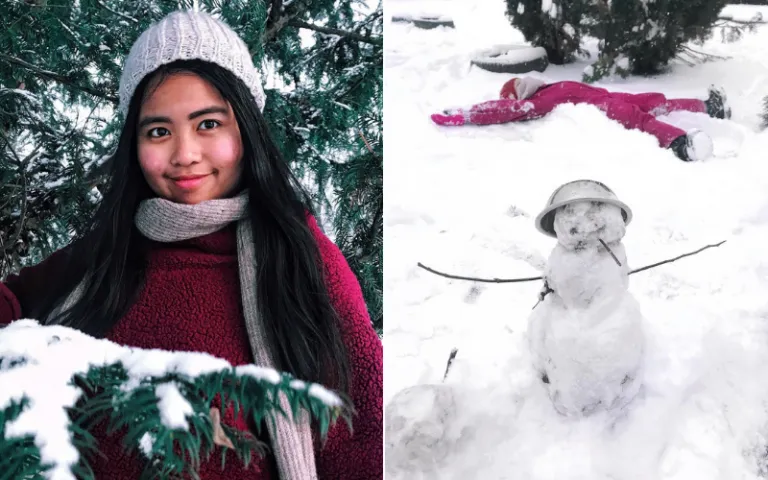
“My life before the war is a far cry from the life I have now. I used to come to school, and as soon as I walked into the corridor, one of my students would rush to hug me. We took the kids to forests, caves, rivers, and mountains. Once, we even took a trip to the longest gypsum cave in the world. We got to see so many crystals underground and walked through mud sculptures depicting famous mythological characters.
Now, I can only teach online. We still try to make the classes engaging and fun, but we mostly stay at home because there’s nothing open outside, and because the Russian forces continue to attack our cities with their air raids.”
On hiking the Carpathian Mountains
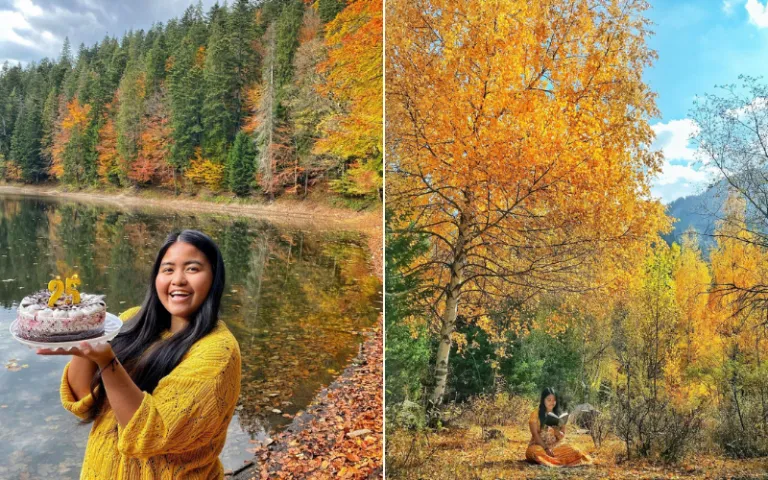
“Before the war, I used to hike the Carpathian Mountains. I live one hour away from the place, so it was easy to get there and sneak in some fresh breath of mountain air. The Carpathian Mountains was my safe haven. I’m an avid hiker, and nothing gives me more serenity than pitching my tent among tall trees, drinking ice cold water from a stream, and looking over a lovely view of snow-capped peaks.
I actually turned 25 years old in the Carpathian Mountains. I brought a cake and a bottle of wine with me and set up a small picnic by Synevyr Lake underneath the colourful autumn trees. The fall foliage mesmerised me, so I spent most of my days painting and taking pictures of the autumn shades.
Sometimes, I’d just enjoy sitting by the river that runs through the verdant forests of the Carpathians. I’d usually bring a book or a bottle of wine and some food to enjoy a picnic. Then, I’d buy homemade jam, honey, tea, cheese, and wine from the mountain grandmas. You know, I love supporting the local economy and giving back to the place that has also given to me.
I wish to go back to hike the Carpathians again. I haven’t gone up Ukraine’s highest peak, Hoverla. When the war ends, I’ll do the seven-day Chornohora Trek. If there’s anything the war reminded me again, it’s that we don’t get to live forever. We don’t know when our time is coming, so when we have the chance to see the world, be with our loved ones, or put ourselves out there, we should grab it because we don’t know whether the opportunity to do so might come again.”
On meeting the people of the mountains
“The people of the Carpathian Mountains are made up of nothing but pure kindness. Hitchhiking and hiking my way around the region was a breeze. Sometimes, I didn’t even have to wait over a minute or stop a car. They would always be willing to offer a ride, especially since public transportation was not always reliable.
They were also very gracious hosts. One time, I decided to live in a homestay in a little town where I would base myself for future hikes. I wanted to get some work done before I disappeared from civilisation. Yolanda, the kind grandma who owns the homestay, ensured I was taken care of from the moment I arrived. Even though it was cold at night when I arrived, she met me halfway so that I wouldn’t get lost and that I would be all settled after my long hitchhiking trip.
Yolanda gave me grapes from her garden and apples to enjoy while going for walks in the mountains. She shared stories about her family and her life in the highlands. Now, I wonder if she’s okay. I hope she and her family are safe and away from all this chaos.”
During our first interview, you shared that you wanted to travel around the Stan countries and Europe. Now that you’ve achieved these, do you have new goals or dreams?
“Well, I haven’t fully explored Europe yet. I’ve only gotten to the Eastern part of it, so I’d like to travel around the continent a bit more.”
On facing travel discrimination
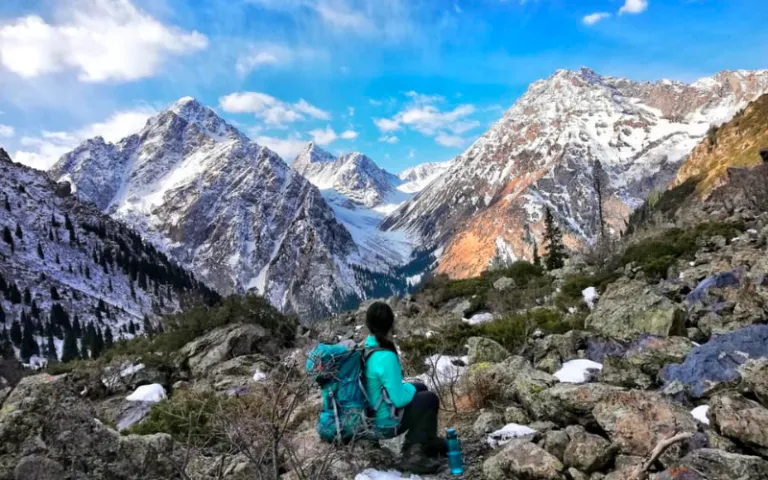
“Last year, I tried entering the Schengen states but faced utter discrimination at my application. I submitted all necessary documents: a healthy bank account with sufficient and regularly deposited funds, flight reservations, copies of my contracts with my students online, my residence permit and registration in Ukraine, proof of volunteer work in the country, hotel bookings and free walking tour vouchers, a copy of my property in the Philippines, a visa to Bulgaria and bookings for accommodations to my next country. Turns out, these documents still weren’t enough, and the Italian Embassy thought that I would be an undocumented immigrant. Did they even take a look at my travel blog or bother to put me outside the stereotype they have for young, unmarried brown women?
I’m determined to enter the Schengen zone and beat the bureaucracy. I believe that everyone who wishes to travel for leisure, education, work, or the fulfilment of their dreams should be able to do so.
Travel shouldn’t be only for the privileged few. It has to be more accessible.
I’m hoping that one day, I’ll be able to contribute towards breaking the barriers that make travel inaccessible for particular races, religions, sexualities, abilities and passport holders. For now, I continue to take up space as a BIPOC creator from a developing country in the travel sphere and devote my platform to raising awareness on travel inaccessibility for minority adventurers.”
On being a sustainable traveller
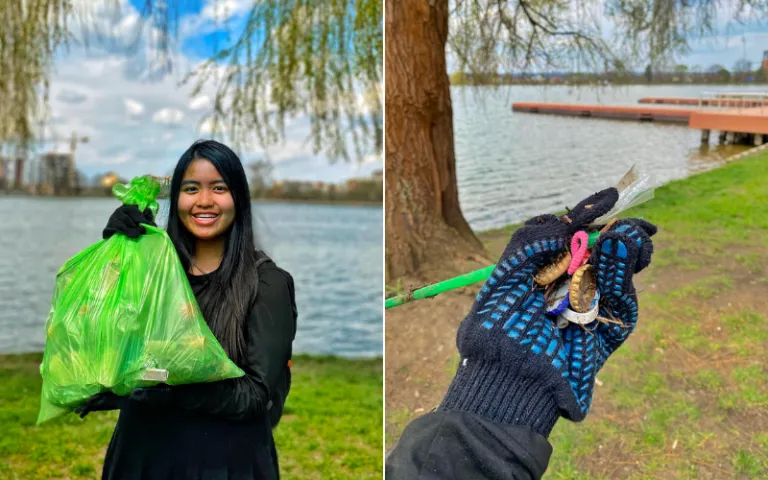
“My next big adventure is hiking the Lycian Way in Turkey. I really want to be able to finish the 440-kilometre trek and use the time on the trail to promote sustainable travel.
By walking the month-long trail itself, I’ll be eliminating my carbon footprint in terms of transport. By pitching my tent along the way, I’ll be consuming less electricity compared to staying in hotels that run water and electricity for 24 hours. When I choose to stay in local homestays, the money I spend goes to a local family running it instead of a huge, invasive hotel that destroys both the local environment and landscape. When I consume local produce in these homestays or in the markets and restaurants I eat at along the way, I minimise my impact when it comes to food consumption. I also get to support local agriculture and businesses.
I want this month-long endeavour to inspire my audience to pay attention to the planet and make sustainable decisions in their adventures.
Although it is fun and insightful, travel can be a big polluter. That’s why I believe that as travellers, we have the responsibility to make ethical and mindful decisions on our trips. We must help preserve or even improve the breathtaking landscapes we visit, the rich cultures we learn about, the people we come across, and the experiences we collect.”
On travelling purposefully
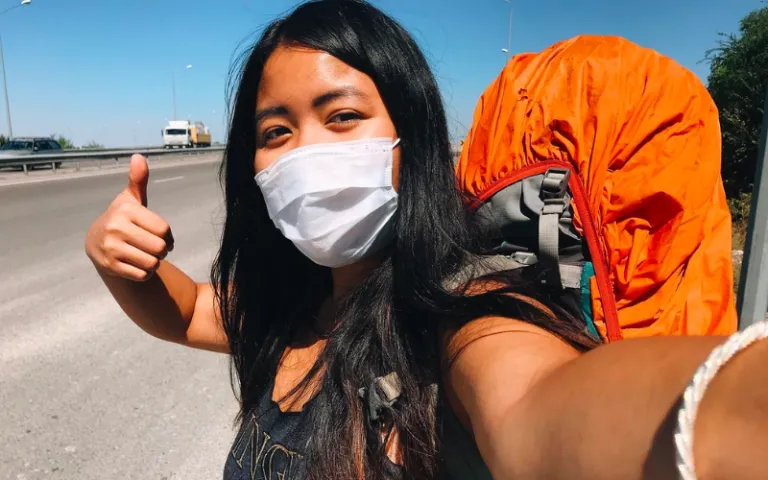
“During the onslaught of the pandemic, I did weekly live sessions to collect donations for public hospitals in the Philippines. We were able to supply PPEs, antiseptic solutions, and face masks to public hospitals that need them. We were also able to send some financial aid to my female friends in Afghanistan when the Taliban took over. Now, as the war rages in Ukraine, I’m collecting funds to provide humanitarian aid for the commuter towns surrounding Kyiv and for war refugees as well.
I think this is the direction Krysten Kaladkarin is taking. Besides amplifying voices, showcasing diverse cultures, and presenting testaments of human kindness, I want my platform to be an agent for change. I want it to be able to teach travellers to make more responsible choices on the road, to call on bureaucracies and powerful organisations to make travel more accessible for those who wish to do so, and most importantly, to give back to all these welcoming communities.
I want to revolutionise the way we travel to make it more purposeful and make sure it positively affects every place we visit. And, I hope the next generation of travellers would get to see and experience the world the way I did and realise that, wow, this is something worth preserving. This is something worth making better. This is something worth fighting for.”
Any last words for those who follow your journey as Krysten Kaladkarin?
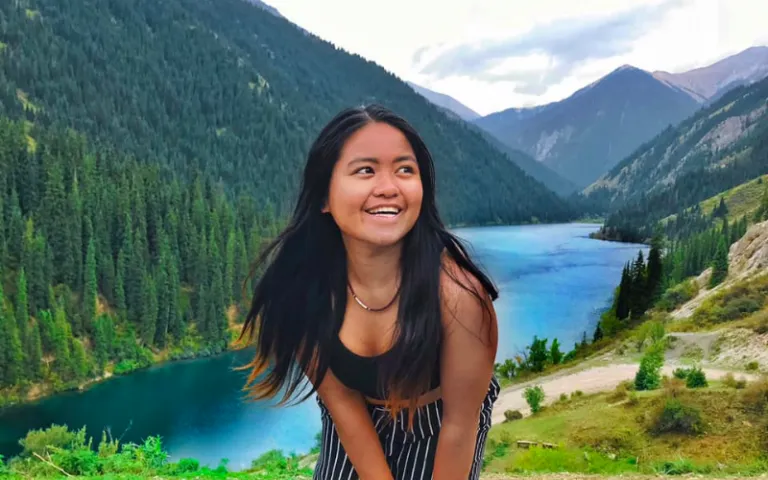
“I look back at that 21-year-old girl then and see how much she’s grown. The way she travelled then isn’t so much the way I travel now but look at that. She has found everything she was looking for: freedom, happiness, home, and a deeper understanding of the world around her.
I’m so proud of the person I’ve become. I’m so proud of how this epic adventure has shaped me to become this brave, creative, and passionate individual, with all these colourful stories and with a heart that always strives to give back and change the world.
I can’t wait to see where the next adventures would take me and what kind of traveller I’ll be then. I can’t wait to see how many more lives I’ll touch, how many more languages I’ll learn, how many more cuisines I’ll taste, how many more cultures I’ll celebrate, and how much more change I’ll get to spark in the world.
When that happens, I hope we can catch up with each other.”
Catch Krysten Kaladkarin on her website and her Facebook, Instagram, TikTok, and YouTube accounts. Quotes were edited for clarity, style, and flow.
Published at
About Author
Danielle Uy
Subscribe our Newsletter
Get our weekly tips and travel news!
Recommended Articles
10 Bantayan Island Resorts, Hotels, and Rentals for Your Tropical Escape 10 Best Mountain Cafes in the Philippines for Your Peak Coffee Experience Coffee date on the mountains, anyone?
10 Best Things to Do in Los Angeles Los Angeles is more than Hollywood stars. From hikes with killer views to beaches straight out of a rom-com, here are 10 must-do LA experiences for Filipino travellers or any wanderers in general!
10-day Christmas and New Year Japan Trip: Complete Travel Itinerary Celebrate Christmas and New Year in Japan with this 10-day holiday vacation itinerary packed with Tokyo lights, Kyoto charm, and Osaka adventures.
10 Fairytale Castles In Europe Filipinos Need To See! Permission to feel like royalty even for a day?!
Latest Articles
PAL’s New ‘Safetynovela’ Goes Viral as Netizens Praise Creative Twist on Flight Safety Video Pre-flight briefings are made fun again!
E-bikes, E-trikes Ban in Metro Manila Starts Jan. 2 with Mandatory Impounding Full list of prohibited routes and what you need to do to keep your e-trike.
6 Filipino Foods to Eat During New Year's Eve for Better Luck and Wealth in 2026 Lucky Filipino foods you need for a prosperous Year of the Fire Horse!
FREE NYE 2026 Countdown & Firework Shows in the Philippines Don't waste ₱17k on hotel tickets! Catch SB19, Bamboo, and Ely Buendia for FREE.
New US Biometric Rule Filipino Travellers Must Know Mandatory border photo checks

